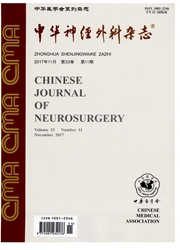

 中文摘要:
中文摘要:
目的探讨儿童脑干海绵状血管畸形的临床特征及预后。方法回顾27例手术治疗的儿童脑干海绵状血管畸形的临床资料。采用KPS评分对手术前后及随访状况进行评估,比较手术前后与随访KPS评分的差异。结果全切除26例,部分切除1例,手术前后平均KPS评分分别为(71.85±15.20)、(68.15±7.86);随访27例,时间为12—138个月,随访平均KPS评分为(87.78±9.34),均无再次出血。手术前后KPS评分差异无统计学意义(P=0.106),随访KPS评分较术后明显增高(P〈0.01)。结论手术治疗对儿童脑干海绵状血管畸形患者有积极作用,长期预后良好。
 英文摘要:
英文摘要:
Objective To investigate the clinical characteristics of brainstem cavernous malformation (BCM) in childhood and its treatment strategies. Methods Clinical data of 27 patients with BCM who received surgical treatment were analyzed retrospectively. Karnofsky performance scale ( KPS ) score was used to evaluate the pre - , post - operative and follow - up status. The differences between pre - operative KPS and post - operative KPS as well as between post - operative KPS and follow - up KPS were analyzed statistically, respectively. Results Gross total resection was achieved in 26 cases and subtotal resection was achieved in 1 case. The mean KPS of pre - operative status and post - operative status was 71.85 ± 15.20 and 68. 15 ±7. 86, respectively. All the 27 patients were followed up for 12 to 138 months. The mean follow - up KPS was 87.78 ± 9. 34 and there was no rehemorrhage event in the follow - up period. There was no significant difference between pre -operative KPS and postoperative KPS( P =0. 106 )but significant difference between post - operative KPS and follow - up KPS ( P 〈 0. 01 ). Conclusions The surgical treatment is beneficial to the children with brainstem cavernous malformation. Patients treated by surgery can obtain good long- time prognoses.
 同期刊论文项目
同期刊论文项目
 同项目期刊论文
同项目期刊论文
 期刊信息
期刊信息
